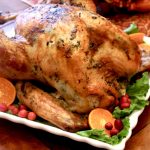Ingredients
Scale
- 12 lb turkey (Anything from 11–15 lbs will work, but bake time will vary – see below)
- Salt & Pepper for the inside and outside of the bird
Flavored Butter:
- 1 cup (2 sticks) unsalted butter, softened
- 2 Tbsp olive oil , plus more to drizzle the top
- 4 Tbsp fresh lemon juice (from 1 large lemon), plus 1/2 Tbsp lemon zest
- 3 large garlic cloves, pressed
- 1/4 cup freshly chopped parsley or 2 Tbsp dried parsley
- *Optional: sub the parsley for fresh rosemary or sage (or some of each) if you prefer
- 1/2 Tbsp salt (I used sea salt)
- 1/2 tsp black pepper, freshly ground
Place inside the Turkey while roasting:
- 1 large onion, quartered (you don’t need to peel)
- 4 garlic cloves, halved (no peeling)
- 1/2 lemon, halved
- 1/2 bunch parsley (optional –if you have some extra)
What you’ll need:
- Kitchen String
- Heavy duty foil
- A heavy roasting pan that accommodates your bird, but not too much larger
- A temperature probe (to ensure a fully-cooked turkey)
Instructions
Tips for prepping your bird:
- *If using a frozen turkey, defrost it in its plastic bag in the refrigerator for 3 days prior to roasting.
- *Remove turkey from fridge about 30 minutes before you start working with it. If the turkey is closer to room temperature, it will bake more evenly.
- *Remove the neck and bag of giblets from the turkey (don’t forget–they are sometimes in plastic bags–not good for roasting!)
- *Rinse turkey with cold water and pat it dry with paper towels. Let turkey sit in a roasting pan lined with paper towels to soak up any excess water from the turkey.
- *Fold the wings behind the turkey; if you don’t they are the quickest to scorch and dry out.
Flavored Butter:
- In a medium bowl, combine: 2 sticks softened butter, 2 Tbsp olive oil, 1/2 Tbsp lemon zest, 4 Tbsp lemon juice, 3 pressed garlic cloves, 1/4 cup chopped parsley, 1/2 Tbsp salt, 1/2 tsp pepper. Mash /stir with a fork until well combined (the lemon juice doesn’t easily stir into butter but keep mixing and it will happen after a few minutes). This smells SO good and does wonders to the turkey while roasting!!
- Separate the skin from the turkey breast by pushing your fingers under the skin. Do this from the front and the back of the turkey; being careful not to tear the skin.
- Stuff 2/3 of the butter mixture under skin then spread the butter around by massaging over the top of the skin. This butter keeps the turkey breast tender, juicy and provides rich flavor.
- Rub remaining butter over the outside of the turkey (breast, legs, wings). Drizzle all over the top of the turkey with olive oil and generously season with salt and pepper; This will produce a nice golden, crispy, salty skin.
- Fill the turkey cavity with the quartered onion, 4 halved garlic cloves, 1/2 bunch parsley and half a quartered lemon. Tie turkey base and legs together; crossing the legs to better close up the turkey cavity, and looks better when presenting it on your table.
How to Roast a Turkey:
- (Pre-heat the oven to 430˚F. Place oven rack in the lower part of your oven (mine was on the second level from the very bottom).
- To protect the turkey breast and keep it juicy: Fold a large square sheet of foil into a triangle. Rub one side of your triangle with olive oil and shape the foil (oil-side-down) over the turkey breast, then remove foil; it will shield your turkey breast and keep it from getting dry. You’ll apply this shield later in the roasting process.
- If using a standard non digital thermometer place into the bird; beneath the drum stick; deep into the dark meat.If you have a digital one, then you can check it after the timer goes off (or there are certain digital mean themometers that you can keep in while roasting) Start roasting uncovered at 430˚F for 20 min.
- Remove from oven; quickly baste with butter from the bottom of the dish. You can use a baster or tilt one side of the pan and collect drippings with a large spoon.
- Reduce oven to 350˚F and bake for another 2 hours 30 min for a 12 lb bird. After about an hour check to see how the top is looking–if nice and golden brown, apply the triangular piece of tin foil that you prepared earlier, to prevent it from over cooking the breast area. (Once you have reduced the oven to 350˚F, you will bake about 13 min for every pound of turkey). The turkey thigh should register at 170˚F on the temperature probe and the breast at 160˚F to make sure it’s fully cooked through then remove from the oven (keep in mind the turkey temp continues to rise slightly after it’s out of the oven).
- Transfer turkey to serving platter and cover loosely but fully with foil. Let turkey rest for at least 1 hour. This is an important step–It will become more tender and easier to carve, the longer it sits. If you carve it straight out of the oven, all the juices escape and your meat will be dry! Keep the drippings from roasting pan for gravy. Now you can get your turkey ready to present! I like to place it on a bed of greens (romaine is pictured above, but Kale is great too) , then add halved mandarin oranges, and fresh cranberries (or apples, lemons, or bunches of fresh herbs)
